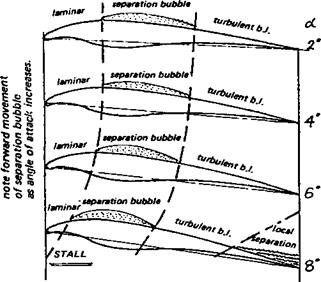SEPARATION BUBBLES
Schmitz did not investigate in detail the size of separation bubbles over his aerofoils, and as shown in Fig. 8.2., these may be very extensive. The Go 801 profile tested by Kraemer is of smaller thickness than the N-60 (10% as against 12.6%). It has a slightly smaller nose radius, but greater camber (7% at 35% compared with 4% at 40%). It thus comes somewhat closer to the thin curved plate profile, and its critical Re is slightly lower than that of N-60. Some detailed measurements made by Charwat at the University of California in 1956 -57 showed that a profile of the shape shown in Figure 8.6, with the small nose radius of 0.7%, also exhibited separation bubbles very similar to those of the 801 profile. The aerofoil in this case, designed by Seredinsky, following one of Schmitz’s suggestions, was based on a prefile of orthodox type, but the underside of the leading edge was cut away to try to produce a profile with room for wing spars, yet with the advantages of a small leading edge radius. In these tests, a separation bubble formed over about 35 to 40% of the chord. Above 7° angle of attack the bubble moved forward. Turbulent flow separation occurred over the rear of the profile prior to the stall, but the profile worked well. The effect of the separation bubble’s formation and movement is of considerable significance. The bubble is sufficiently large to divert the main airstream over the upper surface round a longer path, just as if the profile was more cambered. It has been established that a profile with the maximum camber point well forward develops a high maximum lift coefficient. (This was the reason for the NACA 210 camber form.) The result of this effective camber increase together with bubble movement forward at high angles of attack, is to increase the slope of the lift curve (compare Chapter 5) above that ‘ which is predicted by theory. Such evidence as there is from model operations tends to confirm that some aerofoils on A 2 sailplanes behave erratically. This may be attributable to shifting of the separation bubble, and its flattening effect on the chordwise pressure curve, to and fro on the wing as the angle of attack varies slightly. The fluctuating
pressures over the profile cause sharp changes of the pitching moment which, as shown in Chapter 7, is already large because of the high camber of such wings. The hysteresis loop is caused by the bursting and re-forming of the separation bubble. A model in this critical Re region, capable of stable flight in smooth ‘air, may become uncontrollable in rough conditions. These factors come together with the inherently pitch-sensitive qualities of the high aspect ratio wing to make the model sailplane operator’s difficulties more severe. Providing these problems can be overcome, there is no doubt that, for high performance at low wing Re, thin, small leading-edge-radius profiles, appropriately cambered, are excellent
By adding turbulators to thicker profiles, the low speed performance may be greatly improved, and even with the specialised ‘low critical’ profiles turbulators may be very useful. The turbulators used by Schmitz and others were usually wires mounted ahead of the leading edge on light outriggers; suitable positions for these are indicated in some of the diagrams in Appendix 2. For practical models, wires may be replaced by thin elastic or plastic strings. These are, however, rather a nuisance in operation, and the leading edge ‘trip strip’ may be easier to manage. Such strips have the advantage that they may be lightly pinned or ‘tack glued’ in various positions for trial, and moved or changed in size to give best results. If the critical Re of the profile chosen is already low turbulators cannot have much influence on still air performance. However, by triggering separation at a fixed point on the wing, they probably stabilise the position of the separation bubble, reducing the fluctuations of moment coefficient The result should be an improvement in
Fig. 8.6 Separation and re-attachment on the Seredinsky aerofoil
*** Seredinsky^ ‘————————– Re 38000
|
[observed by A. Charwat. 1957]
|
|
|
controllability of the model. A great deal of work has been done in ‘full-sized’ wind tunnels to determine the minimum size of such trip strips so that they are just big enough to cause transition to turbulent flow without causing wholesale flow separation. (This is because wind tunnel tests at low Re are not applicable to fiill-sized aircraft without such control of the boundary layer transition point) For models, the best approach is that of systematic practical trials with turbulators of varying type and size in various positions.












